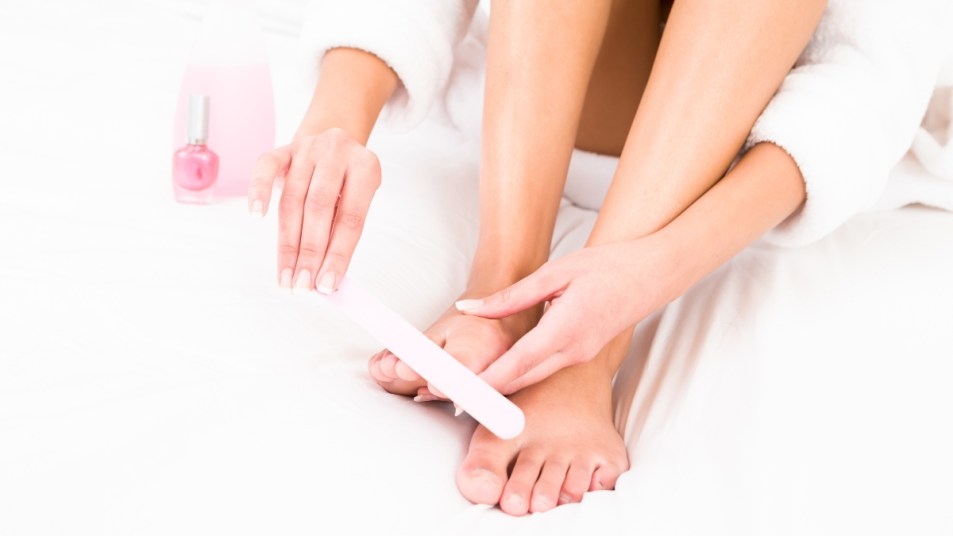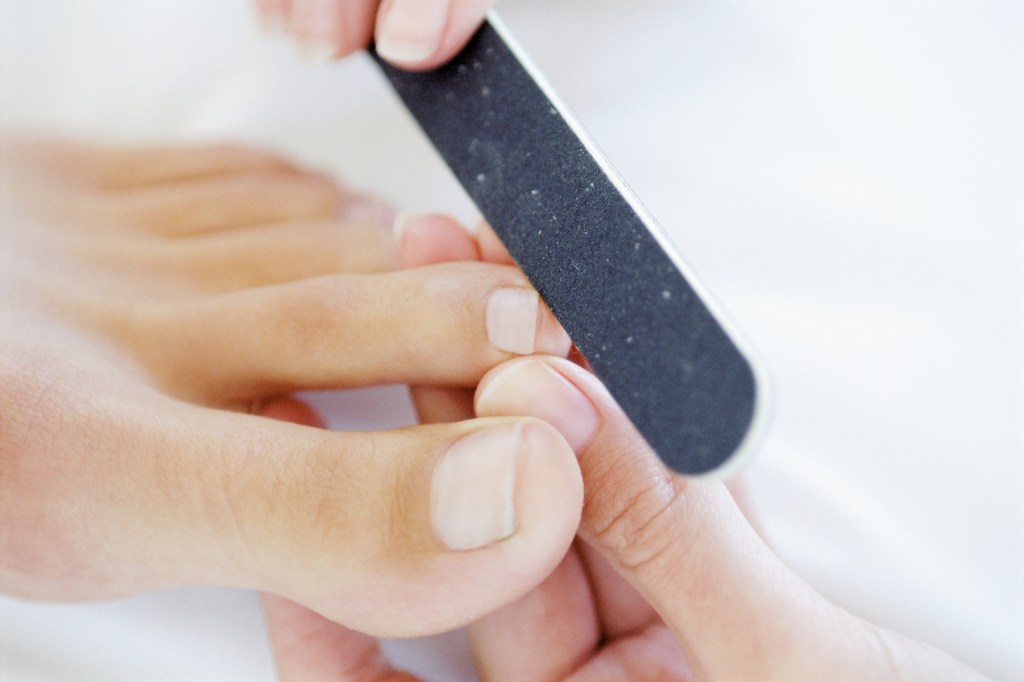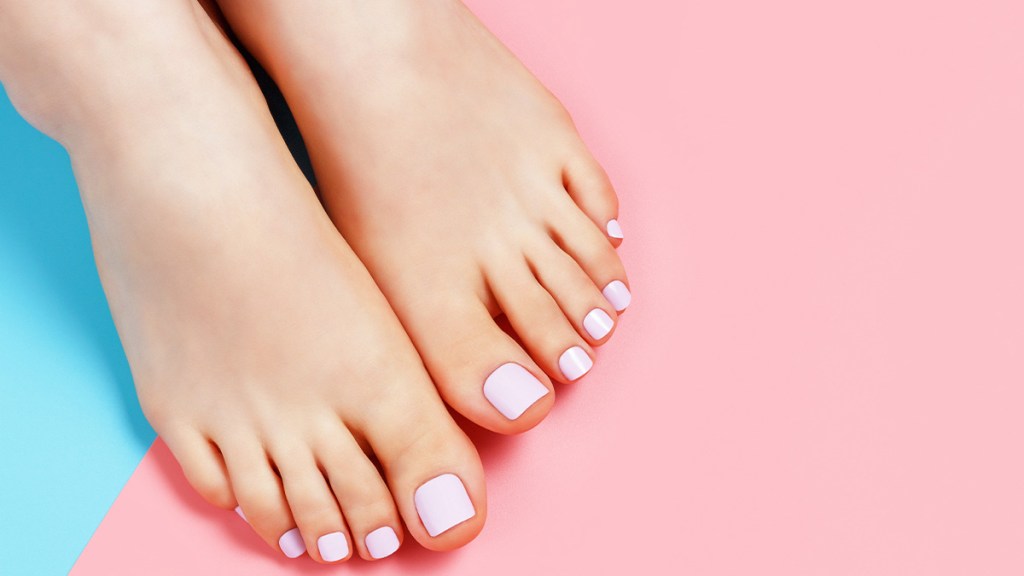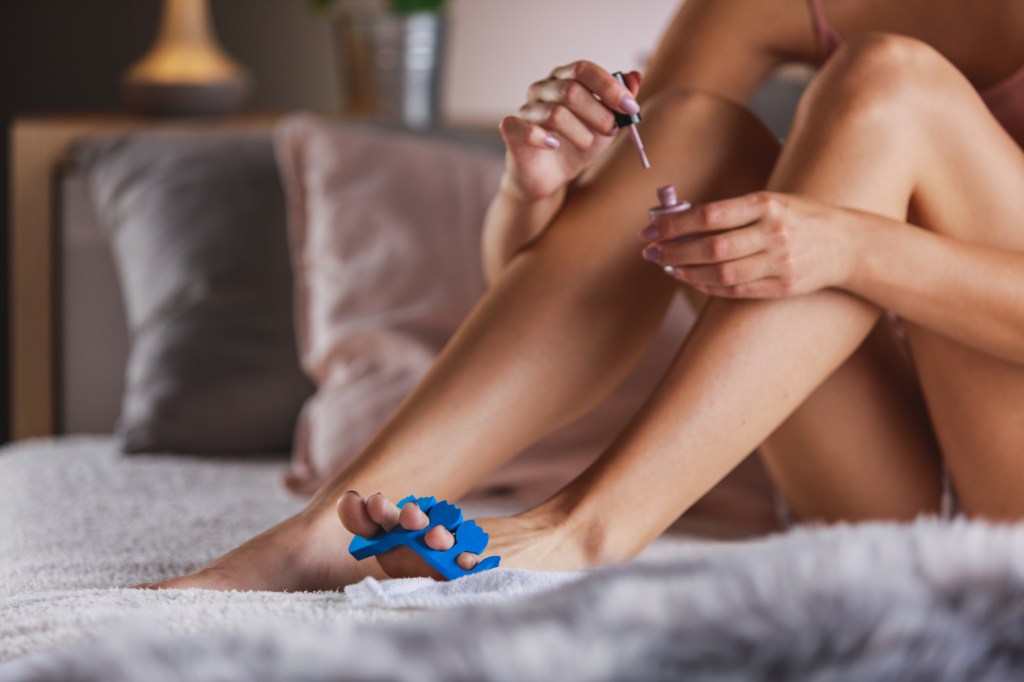New Pedicure Trend Leaves Out *This* Key Ingredient: Nail Pros Reveal Why That’s a Good Thing
Plus how to reap the rewards at home!

One way to instantly feel pampered and renewed is getting a fresh pedicure. And there are so many ways to customize it, from rose-infused treatments to paraffin wax add-ons to fun nail designs. But there’s one kind of pedicure that’s getting more and more buzz: a waterless pedicure — and experts say it might be a good idea to switch from the traditional treatment to this dry one. Here’s all you need to know about waterless pedicures and why you should consider getting one the next time you show up to the salon.
What is a waterless pedicure?

A waterless pedicure is pretty much what it sounds like: It skips the “wet” soaking part during the pampering section of the pedicure that comes before the nail-painting portion. Except for the lack of water, the process is similar in that your feet are cleaned and sanitized, your calluses are buffed and your nails are shaped and (usually) painted.
What are the benefits of a waterless pedicure
1. A waterless pedicure is more sanitary
“Waterless pedicures are more hygienic than standard pedicures since no water is used during the treatment — this reduces the risk of bacterial and fungal infections,” says Dendy Engelman, MD, FACMS, FAAD, board-certified cosmetic dermatologist and Mohs surgeon at Shafer Clinic in New York City. While Dr. Engelman calls the chances of something going awry small, the complications that arise with nail infections may end with lasting impacts. In fact, there are even rare reports of people dying after a nail-related infection. That’s why Marcela Correa, a licensed professional medical pedicurist and owner of Medi Pedi NYC, says, “our decision to adopt a waterless approach stems from a commitment to enhanced sanitation practices.”
2. It can treat other foot concerns
Since waterless pedicures are often medical-grade (as is the case with Medi Pedi NYC), they sometimes go beyond what you might typically see in your local nail salon. Explains Dr. Engelman, “Appropriately licensed nail technicians and waterless pedicure clinics also provide the added benefit of addressing foot concerns beyond the aesthetic, such as ingrown toenails, athlete’s foot fungus, nail discoloration and more.” That means if you’re dealing with any special worries down below your ankles, going water-free at a med-spa may be a good option for you.
3. A waterless pedicure can help nail polish last longer

For services that include nail polish, it can mean a long-lasting paint job. That’s because, as Tamara Di Lullo, a nail artist and an educator for CND, explains, “nails are porous, so when they are wet, they expand and soften the same way a sponge does when wet. That swelling means that any product applied on a swollen wet nail will then retract, causing premature chipping once dry.”
4. It takes less time than a regular pedicure
Another bonus of this type of pedicure is that you will be in and out of the chair faster. “Waterless pedicures are often more time-efficient,” says Correa. “The absence of soaking and drying time associated with traditional pedicures allows for a streamlined process.”
Does a waterless pedicure feel as pampering?
Forgoing the warm, relaxing soak portion of your pedicure doesn’t mean you won’t get that same feeling of self-care. And Di Lullo points out that these pedicures still have pampering elements including professional-grade products, rich lotions, effective exfoliators, hot towels and a relaxing massage, so you still get to leave with a feeling of ahhh!
Adds Correa, “I encourage anyone with concerns about the luxuriousness of the experience to take the risk and try it out for themselves. While our focus is not on nail polish, the outcome is feet that not only feel luxurious but contribute significantly to overall well-being.”
What should you look for in a waterless pedicure?
“When choosing a waterless pedicure, the most important things to look for are a hygienic clinic and appropriately trained, licensed nail technicians,” says Dr. Engelman. “Ensuring that the environment is sanitary and that your feet are being handled by people who are properly trained will significantly improve the quality of the pedicure and reduce the risk of infection.”
How to do that? “Do research on the clinic to make sure that it meets these standards: read reviews and talk to people who have gotten a pedicure there,” Dr. Engelman insists. And, as always, she adds, “You can also speak with the clinic and ask any questions that you may have before booking a pedicure. If you have any specific foot concerns or health conditions that relate to your feet, it’s a good idea to speak with your nail technician about them before starting the pedicure.”
How to do a waterless pedicure at home

Want to get in on the waterless pedicure trend at home? Here are the 5 steps to a DIY dry pedi, according to Di Lullo.
Step 1. Clean feet
Start by rubbing one pump of hand sanitizer all over your unpolished nails and feet.
Step 2. File and push back cuticles
Next, file and shape toenails, then push back cuticles with an orange wood stick. Di Lullo’s pro tip: If cuticles are stubborn, apply one small drop of a cuticle remover and allow it to sit for one minute before cleaning your nails. “It can provide dramatic results without needing to soak!” she insists. Just be sure to neutralize it after 60 seconds with a mist of water from a spray bottle before wiping away. One to try: CND Cuticle Away (Buy from Beyond Polish, $6.55).
Step 3. Smooth calluses
Apply a callus smoother to dry areas on feet, then wrap with plastic wrap or a towel and allow to penetrate for 5 minutes. Two to try: CND Pro Skincare Advanced Callus Smoother (Buy from Amazon, $36.73) and AmLactin Foot Repair Cream (Buy from Amazon, $9.94).
After the 5 minutes are up, remove the plastic wrap or towel and very gently buff calluses using a foot file. Remember, less is more here — calluses protect your feet, so you want to smooth them, not remove!
Step 4. Slather feet with lotion
Wipe away any excess callus smoother, then apply your favorite lotion and let absorb 2 minutes. Next, swipe toenails with nail polish remover or nail cleaner to remove excess moisture from your nails. This is important since the lotion can prevent the polish that’s added in the next step from properly adhering to toenails.
Step 5. Polish toenails
Put on a pair of toe separators and apply your base coat Once dry, apply two coats of nail polish in the shade of your choice. Let dry and apply top coat. Voila — your waterless pedicure is complete! Don’t have toe separators? Packing peanuts can help!
Watch this video from @TheNailTeach on YouTube to see an in-depth tutorial on how to do a waterless pedicure yourself.
For more ways to beautify nails, click through these stories:
Manicurists Reveal the Top Nail Shapes of 2023 That Are Sure to Flatter Your Fingertips
Ask for ‘Shellac Nails’ For the Most Natural Looking Artificial Nails On The Market
Gel Manicures: Nail Artists Weigh In On the #1 Approach To Long-Lasting Nail Beauty













